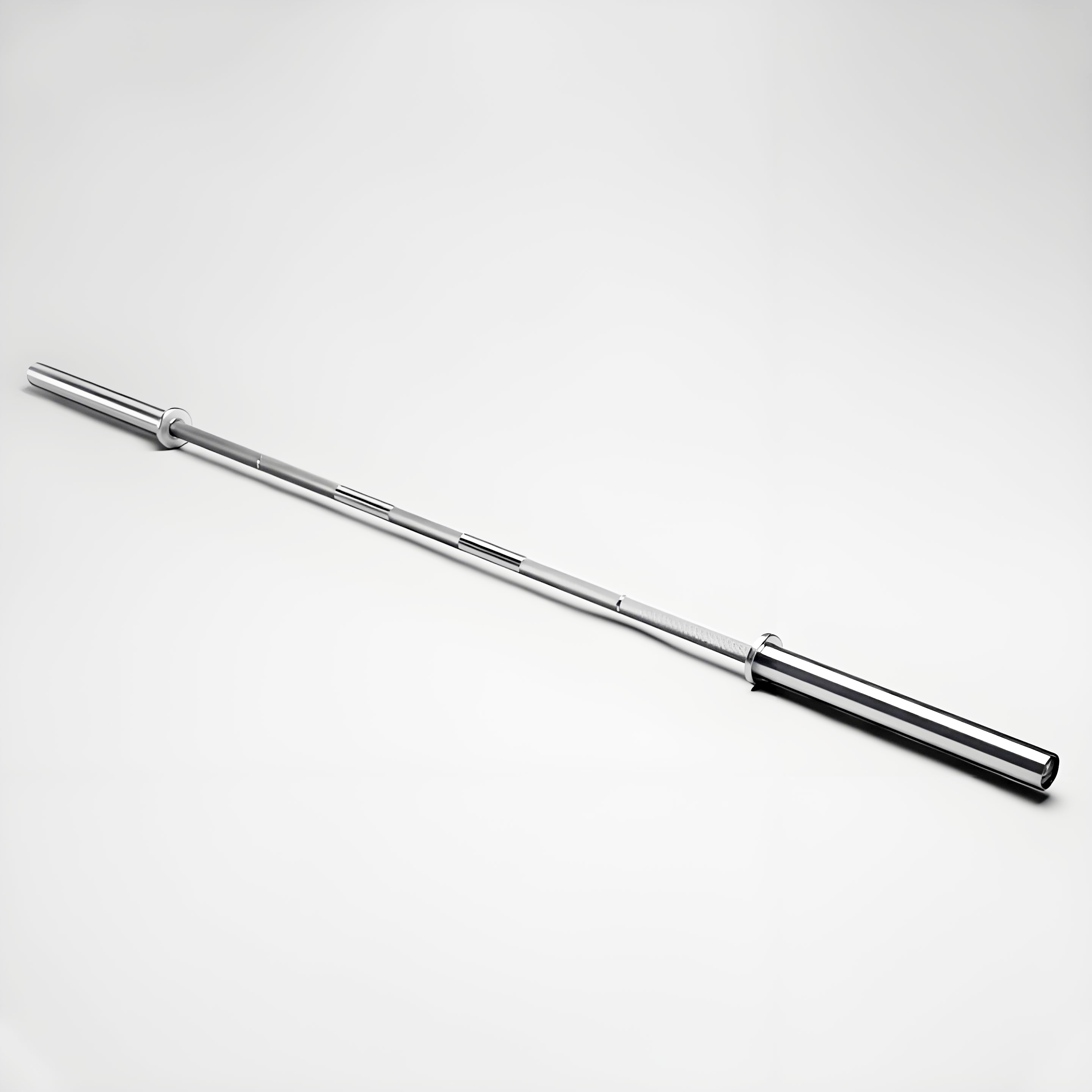OLYMPIC BAR XBB001
The Olympic barbell is a specialized steel bar designed for competitive weightlifting, adhering to strict standards set by the International Weightlifting Federation (IWF). It is optimized for dynamic lifts like the snatch and clean & jerk, balancing strength, elasticity, and grip precision.

Item Code: XBB001 Olympic Barbell
Material: High Grade Spring Steel
Durability: 2000 lbs (240 kpsi)
Weight: 20 KGS (XBB001) / 15 KGS (XBB002)
Knurling: IWF standard knurling
depth: 0.25-0.35 mm
width: 1.2 mm
Finishing: Hard Chromed
Diameter: 28 mm ± 1 mm for Man and 25 mm ± 1mm for Female
Needle Bearings: 10 pcs
Stainless Tubes: 2 pcs
Warranty: 5 years
Olympic barbell development history:
1. Prehistoric and Ancient Eras: Primitive Lifting Tools (Prehistory–19th Century)
- Materials and Usage: Early humans used tree trunks, stone wheels, or handled rocks for strength training. Examples include Greek halteres (stone weights) and Chinese stone locks, primarily used for military drills or ceremonial displays.
- Cultural Symbolism: Weightlifting symbolized heroism or warrior status in many cultures (e.g., Hercules in Greek mythology).
2. Birth of Modern Weightlifting (Late 19th Century–1920s)
- Industrial Revolution Impact: Advancements in steel production enabled the creation of metal barbells. Early designs featured solid iron rods with fixed spherical weights (called "dumbbell-style barbells").
- Early Competitions: Weightlifting debuted at the 1896 Olympics, but rules were inconsistent, and barbells were crude. Athletes performed "one-handed" and "two-handed" lifts with non-detachable iron ends.
- Issues: Solid barbells warped easily, lacked elasticity, and increased injury risks due to rigid design.
3. Standardization and Key Innovations (1930s–1950s)
- Detachable Weight Plates: In 1928, German engineer Karl Swoboda invented removable metal plates secured by collars, revolutionizing training versatility.
- Rotating Sleeves:
- By the 1940s, ball bearings were added to barbell sleeves, allowing independent rotation. This innovation transformed techniques like the snatch and clean & jerk by reducing wrist/elbow strain and improving lift speed.
- IWF Standardization:
- In the 1950s, the International Weightlifting Federation (IWF) defined specifications:
- Men’s bar: 2.2m length, 28mm diameter, 20kg weight;
- Women’s bar: 2.01m length, 25mm diameter, 15kg weight (formalized in 1997 with women’s Olympic inclusion).
- In the 1950s, the International Weightlifting Federation (IWF) defined specifications:
4. Material Science Breakthroughs (1960s–1990s)
- Hollow Steel Tubes:
- 1960s-era hollow forged steel reduced barbell weight to 20kg while boosting bend resistance via heat treatment.
- High-Elasticity Steel and "Whip Effect":
- 1980s chromoly steel alloys allowed controlled flex (up to 1,500 lbs capacity), aiding lifters in harnessing rebound energy during snatches.
- Surface Treatments:
- Chrome/zinc plating improved rust resistance;
- Laser-engraved knurling optimized grip with scientifically calculated grooves (smooth center sections prevented neck abrasion during cleans).
5. Modern Precision Engineering (2000s–Present)
- Material Upgrades:
- Aerospace-grade steel (e.g., Sweden’s Eleiko S235) increased strength and elasticity by 30% over traditional steel.
- Bearing Technology:
- Elite bars use ceramic composites or self-lubricating polymer bearings for near-frictionless spin (e.g., Japan’s Uesaka "silent sleeve" technology).
- IWF Certification:
- Competition bars must pass 20+ tests, including:
- Weight tolerance: ±10g accuracy;
- Flexibility: 2–6mm central deflection under 1,400N load;
- Sleeve rotation: Minimum 3-second spin under self-weight.
- Competition bars must pass 20+ tests, including:
- Customization: Brands like Rogue offer tiered barbells (training vs. competition grade) for diverse needs.
6. Cultural Impact and Iconic Brands
- Eleiko (Sweden): Dominated Olympic supply since the 1950s with IWF-certified bars.
- Uesaka (Japan): Renowned for precision, favored in Asian competitions.
- Chinese Manufacturing: Brands like Zhang Kong Barbell gained global traction with high cost-performance ratios.
Future Trends
- Smart Barbells: Embedded sensors track lift speed, trajectory, and force output (e.g., Italy’s Enode IoT-enabled bars).
- Sustainable Materials: Recycled steel and bio-based coatings to reduce carbon footprint.
From wooden beams to intelligent equipment, the Olympic barbell’s evolution epitomizes humanity’s relentless pursuit of strength and technological mastery.

